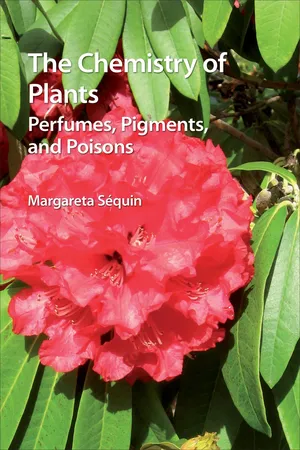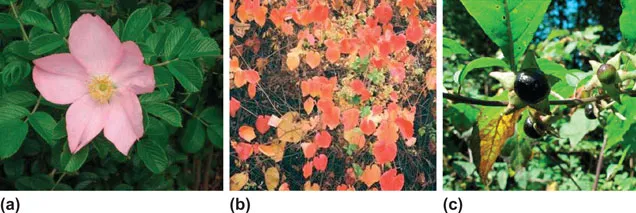
- English
- ePUB (mobile friendly)
- Available on iOS & Android
About This Book
This book is an introduction to organic chemistry and its compounds as related to plants. Chemistry tends to be seen as a field that is hard to comprehend and that has few connections with the living world. This book fills a gap as it eases access to organic chemistry by connecting it with plants and includes numerous photos and other illustrations. The book is a combination of organic chemistry with the living world of plants and is an introduction to organic plant compounds for the non-chemist. It starts with a review of basic concepts of chemistry as they relate to plant life, followed by an introduction to structures of organic compounds, which prepares the reader for the following chapters on primary metabolites and on plant fragrances, pigments, and plant defensive compounds. The final chapter relates plant compounds to human life, with subchapters on foods from plants, medicines, psychoactives, fibers, and dyes. Historic discoveries of plant compounds and their developments to contemporary uses, like modern pharmaceuticals, and a section on genetically modified plants, connect with topics of recent interest. The book leads the serious reader from chemistry basics to complex plant substances and their human uses and plant photos and stories accompany chemistry topics and chemical structures to aid understanding. The author, an organic chemist and plant enthusiast, has taught popular undergraduate college level courses on plant chemistry to non-chemistry majors and numerous field seminars to the general public for more than fifteen years. The book's topics and contents have been taught for many years and have proved successful in providing an understanding of plant compounds, organic compounds, and their importance. The book provides a basis for a better understanding of chemistry and its connections to the world of plants, the natural world in general, and to daily life. It is aimed at non-chemistry undergraduate students and to people in general who are interested in plants and who would like to learn more about them. It addresses an audience with little previous chemistry knowledge, yet, leads the serious reader to an understanding of sometimes complex plant compounds, by providing an introduction to chemistry basics, combining the chemistry with pictures and stories, and using simple, clear language. The book can be used both as a text to introduce organic chemistry as it relates to plants and as a text of reference for more advanced readers.
Frequently asked questions
Information
1.1 INTRODUCTION

(a) A fragrant wild rose (Rosa rugosa). (b) Colorful fall foliage of a grapevine (Vitis cultivar). (c) Branch of a deadly nightshade plant (Atropa belladonna). (Photo by Ruth Marent.)
1.2 PLANTS AND THEIR ELEMENTS
| Element | Some major functions | Sources |
| Macronutrients | ||
| Carbon | Essential component of organic compounds. | CO2 |
| Oxygen | Major component of organic compounds. | H2O, O2 |
| Hydrogen | Major component of organic compounds. | H2O |
| Nitrogen | Component of nucleic acids, proteins, chlorophyll, alkaloids. | NO3−, NH4+ |
| Sulfur | Component of some amino acids, proteins, coenzymes. | SO42– |
| Phosphorus | Component of nucleic acids, ATP, phospholipids, coenzymes. | H2PO4−, HPO42– |
| Potassium | For osmotic balance, operation of stomata; enzyme activator. | K+ |
| Calcium | Required for formation and stability of membranes; activation of some enzymes. | Ca2+ |
| Magnesium | Component of chlorophyll; activates many enzymes. | Mg2+ |
| Micronutrients | ||
| Iron | In chlorophyll synthesis, activates some enzymes. | Fe3+, Fe2+ |
| Chlorine | For ion balance; in water-splitting process of photosynthesis. | Cl− |
| Boron | Cofactor in chlorophyll synthesis. | H2BO3− |
| Manganese | Activates enzymes; in chlorophyll synthesis. | Mn2+ |
| Copper | Involved in redox reactions. | Cu2+, Cu+ |
| Zinc | Activates enzymes. | Zn2+ |
| Molybdenum | Essential for nitrogen fixation. | MoO42– |
| Nickel | Cofactor for enzyme in nitrogen metabolism. | Ni2+ |
Table of contents
- Cover image
- Title page
- Copyright
- Preface
- Contents
- Chapter 1 Basic Plant Chemistry Concepts
- Chapter 2 The Molecular Building Blocks
- Chapter 3 Perfumes, Fragrant or Foul
- Chapter 4 Colorful Plant Pigments
- Chapter 5 Poisons and Other Defenses
- Chapter 6 Plants and People
- Epilogue
- Glossary
- Photo Credits
- Subject Index